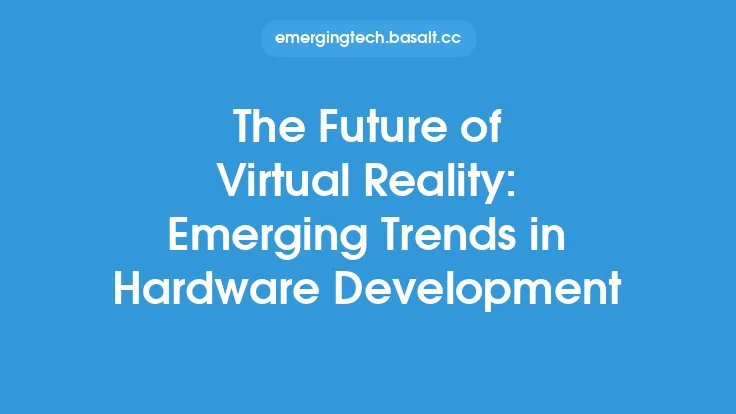The world of virtual reality (VR) has undergone significant transformations in recent years, with advancements in VR headsets being a key driver of this growth. These devices have evolved from bulky, expensive, and limited prototypes to sleek, affordable, and feature-rich products that are changing the way we experience and interact with digital content. At the heart of this revolution are the technological innovations that have enabled VR headsets to deliver immersive, interactive, and engaging experiences that were previously unimaginable.
Introduction to Virtual Reality Headsets
Virtual reality headsets are wearable devices that provide a computer-generated simulation of a three-dimensional environment, allowing users to immerse themselves in virtual worlds, interact with virtual objects, and experience a sense of presence that is unparalleled in traditional computing. These headsets typically consist of a head-mounted display (HMD), sensors, and controllers that work together to track the user's movements, render graphics, and provide haptic feedback. The development of VR headsets has been driven by advances in display technology, computer hardware, and software, which have enabled the creation of high-resolution, low-latency, and affordable devices that are accessible to a wide range of users.
Key Components of Virtual Reality Headsets
A typical VR headset consists of several key components, including the display, optics, sensors, and controllers. The display is responsible for rendering the virtual environment, and it is usually a high-resolution screen with a high refresh rate to minimize latency and prevent motion sickness. The optics include lenses that focus the image and provide a wide field of view, while the sensors track the user's head movements and translate them into virtual movements. The controllers are used to interact with virtual objects and provide haptic feedback, which enhances the sense of presence and immersion. Other components, such as audio systems and tracking systems, also play a crucial role in delivering a seamless and engaging VR experience.
Display Technology in Virtual Reality Headsets
The display technology used in VR headsets is a critical component that determines the quality of the virtual experience. There are several types of displays used in VR headsets, including OLED (organic light-emitting diode), LCD (liquid crystal display), and LED (light-emitting diode) displays. OLED displays are commonly used in high-end VR headsets due to their high contrast ratio, fast response time, and wide color gamut. LCD displays are also widely used, particularly in mid-range and budget VR headsets, due to their lower cost and higher pixel density. LED displays are less common in VR headsets but are used in some high-end devices due to their high brightness and fast response time. The resolution of the display is also an important factor, with higher resolutions providing a more detailed and immersive experience.
Tracking Systems in Virtual Reality Headsets
Tracking systems are a critical component of VR headsets, as they enable the device to track the user's movements and translate them into virtual movements. There are several types of tracking systems used in VR headsets, including optical, inertial, and acoustic tracking systems. Optical tracking systems use cameras and sensors to track the user's head movements, while inertial tracking systems use accelerometers and gyroscopes to track the user's movements. Acoustic tracking systems use sound waves to track the user's movements, and they are commonly used in high-end VR headsets due to their high accuracy and low latency. The choice of tracking system depends on the specific application and the level of accuracy required, with optical tracking systems being the most widely used due to their high accuracy and reliability.
Advantages and Applications of Virtual Reality Headsets
Virtual reality headsets have a wide range of applications, from gaming and entertainment to education and training. They provide an immersive and interactive experience that can enhance learning, improve skills, and increase engagement. In gaming, VR headsets enable players to immerse themselves in virtual worlds, interact with virtual objects, and experience a sense of presence that is unparalleled in traditional gaming. In education, VR headsets can be used to create interactive and immersive learning experiences that enhance student engagement and improve learning outcomes. In training, VR headsets can be used to simulate real-world scenarios, providing a safe and controlled environment for trainees to practice and develop their skills.
Challenges and Limitations of Virtual Reality Headsets
Despite the many advantages and applications of VR headsets, there are also several challenges and limitations that need to be addressed. One of the main challenges is the high cost of VR headsets, particularly high-end devices that require powerful computers and specialized hardware. Another challenge is the limited content available for VR headsets, with many developers still experimenting with the technology and creating new experiences. The risk of motion sickness and eye strain is also a concern, particularly for users who are new to VR or who experience prolonged exposure to virtual environments. Finally, the social isolation and potential addiction associated with VR headsets are also concerns that need to be addressed, particularly as the technology becomes more widespread and accessible.
Future Developments and Trends in Virtual Reality Headsets
The future of VR headsets is exciting and rapidly evolving, with several trends and developments that are expected to shape the industry in the coming years. One of the main trends is the development of standalone VR headsets that do not require a computer or console to operate. These devices are expected to be more affordable and accessible, providing a more seamless and convenient VR experience. Another trend is the development of high-resolution displays with higher refresh rates, which will provide a more detailed and immersive experience. The integration of artificial intelligence and machine learning into VR headsets is also expected to enhance the user experience, providing more personalized and interactive experiences. Finally, the development of new applications and content for VR headsets, such as social experiences and interactive stories, is expected to drive growth and adoption in the industry.




